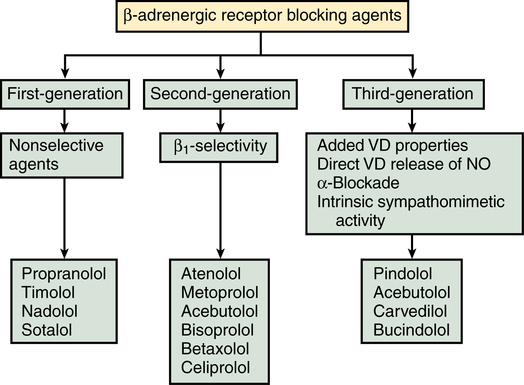β-adrenergic receptor blocking agents
The β1-adrenergic receptor located on the cardiac sarcolemma is coupled to adenyl cyclase via a G protein. When activated, adenyl cyclase converts adenosine triphosphate (ATP) to cyclic adenosine monophosphate (cAMP), a secondary intracellular messenger, that stimulates protein kinase A to phosphorylate membrane calcium channels, leading to an increase in cytoplasmic Ca2+. The consequences of β1-adrenergic stimulation are positive inotropy, chronotropy, dromotropy, and lusitropic relaxant effect (the latter by increasing the reuptake of cytosolic calcium into the sarcoplasmic reticulum). Because the secondary messenger cAMP is metabolized by phosphodiesterase, phosphodiesterase inhibitors augment β1 activity, which is manifested by sympathomimetic effects. Because of inhibition of G protein (e.g., vagal [muscarinic] stimulation), the coupling with adenyl cyclase is interrupted, resulting in attenuation of the effects described previously—the similar effects observed with inhibition of the β-receptor itself (Figure 91-1).
Indications for β-adrenergic receptor blockade
Because of their negative dromotropy, inhibitory effects in the sinus and atrioventricular nodes, and other antiarrhythmic properties (Table 91-1), β-adrenergic receptor blocking agents are recommended to acutely and chronically treat a number of tachyarrhythmias. They are indicated to treat supraventricular tachycardias, to control the rate in patients with atrial fibrillation, and to treat ventricular tachyarrhythmias (specifically metoprolol and sotalol [class III antiarrhythmic]). β-Adrenergic receptor blocking agents also counteract the arrhythmogenic effects of excess catecholamine stimulation, as seen, for example, in patients after myocardial infarction.
Table 91-1
Characteristics of Commonly Used β-Adrenergic Receptor Blocking Agents
| Drug | Bioavailability (%) | Protein Binding (%) | Elimination Half-life (h) | Major Elimination Pathway | Other Properties |
| Atenolol | 50 | 15 | 6-9 | Renal | β1-Selective |
| Carvedilol | 30 | 95 |






